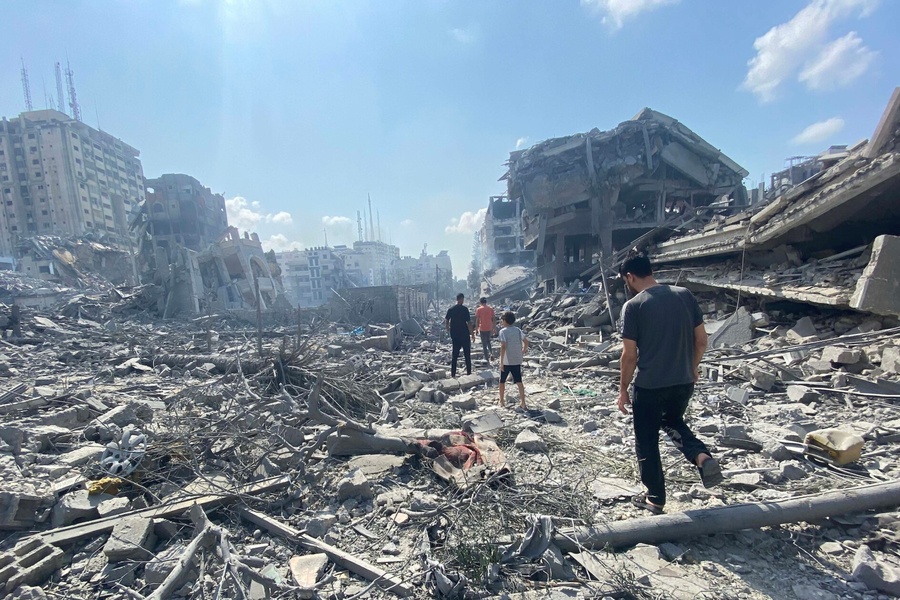Russia’s Recent Space Activity Is a Return to Old Form
Russia appears to have resumed anti-satellite weapons testing. What’s so dangerous about the Russian tests? What can the U.S. do to respond?

Published by The Lawfare Institute
in Cooperation With

The U.S. Space Force stated on Feb. 10 that there have been several recent instances of Russian satellites maneuvering into similar orbital paths as known U.S. spy satellites, specifically USA-245. While some commentators have suggested that these may be “inspector satellites,” whose purpose is to examine the U.S. satellites and determine their capabilities, this activity likely signals a return to form of Russian anti-satellite (ASAT) weapons testing.
Russia has historically relied on co-orbital ASAT weapons to counter adversary space assets. The recent satellite maneuvers suggest that Russia is conducting dry runs to prepare to intercept strategic space assets with other orbital vehicles. These maneuvers, and other rendezvous and proximity operations (RPO), can publicly be presented by the Kremlin as peaceful demonstrations to test the ability to refuel or repair other satellites while hiding their second-order purpose of testing co-orbital intercept capabilities.
This Russian posturing likely signals a resurgence in co-orbital intercept capability as the primary means of adversary space-asset destruction—a reemergence that conveniently coincides with the creation of the U.S. Space Force. Further, these actions once again reinforce the need for the United States to address rules for kinetic satellite engagements and RPO activities on the international stage.
During the Cold War, the USSR chose to pursue primarily co-orbital systems instead of the direct-ascent nuclear-tipped systems favored by the United States with Department of Defense Projects 437 and 505. While direct-ascent anti-satellite weapons take the form of traditional missiles launched from ground-based platforms similar to air-defense weapons, co-orbital weapons are launched into space and then maneuvered into an orbit calculated to collide with the target satellite. In 1961, Russia began developing its first co-orbital system, known as Istrebitel Sputnikov (IS), or Fighter Satellite. These satellites were loaded onto modified intercontinental ballistic missiles (ICBMs) and placed into the same coplanar orbit as the target satellite. The IS would then maneuver to within a maximum of 1 kilometer from a target satellite and detonate onboard explosives, showering the target with fragmentation. In some cases, the targeted satellite even happened to have been launched onboard the same rocket that placed the IS in orbit; other targets were hypothesized to be defunct or limited-use satellites that had reached the end of their lifespan. The IS was tested approximately 20 times between 1963 and 1982, with several live tests resulting in confirmed satellite kills.
The IS system may not pose as significant a threat to U.S. space dominance today as it did during the height of the Cold War because the IS system is hamstrung by its low earth orbit (LEO) engagement limitation, a maximum altitude of about 2,000 km. The global positioning satellites the U.S. relies on for navigation, precision weapons guidance and other warfighting functions are generally placed in medium earth orbit (MEO) at an altitude of 20,000 km, well above the IS launch vehicle’s reach. To be sure, vital national security assets are still at risk from LEO co-orbital intercepts, such as the previously discussed National Reconnaissance Office satellite USA-245. Just this week, Russia has taken steps to ensure that its direct-ascent weapons platforms are capable of intercepting targets in LEO—U.S. Space Command noted that on Apr. 15 Russia tested such a weapon.
But Russia continued to develop other co-orbital ASAT weapons in the mid-1980s that put geostationary orbit (GEO) targets, such as next-generation reconnaissance satellites, within reach. The ASAT system, known as the Naryad, is believed to have been designed to reach altitudes as high as 40,000 km and contain multiple co-orbital warheads. Today, the Naryad’s upper stage is still routinely used to put payloads into orbit as part of the Rokot/Briz staging combination.
Further, the Naryad ground-control station was returned to Russian control from Tajikistan in the mid-2000s. Recent upgrades suggest that the station can now detect and track objects as high as 50,000 km, threatening critical U.S. position, navigation and timing (PNT) assets in GEO. Russia continues to successfully launch and orbit payloads using the Rokot/Briz, so it appears quite feasible that Russia could swap a Rokot/Briz standard commercial payload for a Naryad or other co-orbital craft with minimal additional preparations. The ability to rapidly swap a Naryad vehicle onto a Rokot/Briz may hinder U.S. efforts to both detect and respond to a future ASAT launch since the Rokot/Briz has an established history of carrying nonthreatening commercial payloads into orbit.
The recent Space Force report of two Russian satellites tailing a U.S. spy satellite is only the most recent example of a pattern of escalation exhibited by Russia. In 2014, Russia launched the Olymp-K (or Luch) spacecraft into GEO orbit, though the international community has yet to accurately determine the name of the craft and verify its purported mission. Since its launch, Olymp-K has occupied 14 different positions in the highly congested GEO belt and, most notably, placed itself in a narrow window between two satellites belonging to Intelsat, a private satellite company. Russia dismissed public statements of concern from both Intelsat and the Department of Defense regarding the unannounced and unsanctioned RPO activities of Olymp-K, stating that “the possibility of a collision or of some kind of interference is extremely small.” Importantly, this activity demonstrates the possibility of placing a dormant co-orbital payload into orbit, and later activating and maneuvering the payload into kill-proximity of a target when needed. Olymp-K is a perfect example of the dangers posed by co-orbital ASAT weapons. Had Russia instead launched a Naryad payload, the co-orbital ASAT would have laid dormant and exhibited nonthreatening behavior until activated to intercept a chosen target, allowing it to go undetected by the U.S. until it was too late.
While a dormant co-orbital payload placed into orbit would surely be cataloged by the U.S. Space Surveillance Network (SSN), observers have raised concerns about the amount of time required to detect and catalog intentional changes in an object’s orbit. Then-U.S. Air Force Col. Mark Baird, for example, argues that the United States’s current network of radar and telescopes used to track objects in space is subject to both natural and technological limitations that inhibit a timely operational picture of a rapidly changing situation in space. These limitations, combined with human decision-making vulnerabilities inherent in reacting once a threat is finally identified, create opportunities for dormant co-orbital weapons to be highly devastating to critical space assets. This raises concerns that adversaries could play a continuous shell game with co-orbital weapons, changing orbits to obscure where these payloads are until activated. Because there is a significant delay in cataloging orbit changes and maneuvers, co-orbital weapons could be activated and intercept their targets with little to no warning.
Despite several opportunities in recent years, the United States has continuously failed to address the increasing threat ASAT weapons pose to both space dominance and freedom of navigation. The U.S. responses to both China’s destruction of its weather satellite FY-1C in 2007 and India’s destruction of the Indian Ministry of Defense’s Microsat-R in 2019 were viewed largely as lackluster. Some commentators have suggested that the United States missed an occasion during the controlled destruction of USA-193 in 2008 to reinforce international norms concerning the Outer Space Treaty’s consultations provision. According to Article IX of the Outer Space Treaty, a state must “undertake appropriate international consultations before proceeding with any such activity” that may interfere with the peaceful use of outer space by any other nation. While the U.S. did announce its intentions to destroy USA-193 as it reentered the atmosphere, one could argue that announcing intentions does not meet the threshold of international consultations envisioned by Article IX. If the U.S. had engaged in more robust international consultations before the 2008 destruction, it would have sent a clear international message about the importance of Article IX. The ASAT tests conducted by China and India would seem to clearly fall within the provisions of Article IX; the debris created from the destruction of FY-1C forced the Terra spacecraft to permanently change its orbit, and the destruction of Microsat-R placed the International Space Station in severe danger.
Where the United States has left a vacuum of inaction, Russia and China have taken the lead on shaping the ASAT conversation with their own proposals to the international community, the “Treaty on the Prevention of the Placement of Weapons in Outer Space, the Threat or Use of Force Against Outer Space Objects” (known as the PPWT). And while the U.S. Permanent Mission to the Conference on Disarmament addressed the shortcomings of the proposed PPWT, the U.S. has since failed to offer its own solution. Many of the restrictions contained in the PPWT on space-based weapons were designed to counter a perceived U.S. technological advantage achieved through the decades-long work done by the Strategic Defense Initiative.
The United States must take an assertive stance in countering this behavior by proposing a new international framework that shapes restrictions and norms on behavior in outer space. And to advance U.S. strategic interests, a U.S.-proposed framework must include a prohibition on unsanctioned rendezvous-and-proximity maneuvers around foreign satellites, like those observed recently near USA-245, by defining them as a threatening action. Further, co-orbital ASAT weapons need to be clearly classified as space-based weapons platforms, not as simply a payload launched by a direct-ascent weapon. Classifying these weapons as space-based counter-space weapons will ensure that they would be prohibited under any Russian or Chinese position advanced by the PPTW. As it stands, co-orbital ASAT weapons are likely to sidestep PPTW prohibitions because they are delivered by a ground-based launch vehicle.
Continuing to respond with ambivalence to the use of kinetic energy ASAT weapons, including co-orbital payloads, places critical assets at risk from the proliferation of debris in orbit, and further exacerbates the shortcomings of the SSN’s ability to detect threats. Any new international framework must establish specific protocols for conducting rendezvous-and-proximity maneuvers, especially when those maneuvers are conducted around foreign spacecraft.
The opinions expressed here do not represent those of Vanderbilt University, the United States Army, the Department of Defense or any part of the United States government.




-(1).png?sfvrsn=fc10bb5f_5)
